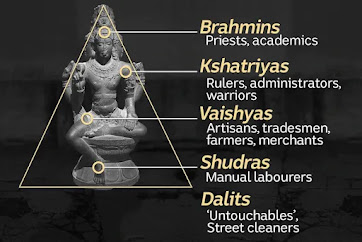About Caste Discrimination
Caste discrimination is a highly politicised and sensitive issue in India. Despite constitutional safeguards and special legislation for the protection of the country’s 201 million ‘scheduled castes’ (the official term for Hindu, Sikh and Buddhist Dalits), violations of their fundamental human rights continue on a massive scale. Key issues include access to justice and rising violence against Dalits, multiple discrimination against Dalit women, slavery and child labour, discrimination in education, untouchability and access to basic services including humanitarian aid, social and economic rights and shrinking space for Dalit human rights defenders.
Caste discrimination is basically a system that separate peoples on the basis of their caste. India's caste system is among the world's oldest forms of surviving social stratification. The system which divides Hindus into rigid hierarchical groups based on their karma (work) and dharma (the Hindi word for religion, but here it means duty) is generally accepted to be more than 3,000 years old. For this it is present for a very long time in our country.
The caste system divides Hindus into four main categories - Brahmins, Kshatriyas, Vaishyas and the Shudras. Many believe that the groups originated from Brahma, the Hindu God of creation. This division done on the basis of their work . At the top of this division is the Brahmins who were mainly teachers and intellectuals and are believed to have come from Brahma's head. Then in second the Kshatriyas came , the warriors and rulers, supposedly from his arms. The third slot went to the Vaishyas, the traders, who were created from his thighs. At the bottom of the heap were the Shudras, who came from Brahma's feet and did all the menial jobs. The main castes were further divided into about 3,000 castes and 25,000 sub-castes, each based on their specific occupation.
The government has formulated various acts and laws to stop this practice. Independent India's constitution banned discrimination on the basis of caste, and, in an attempt to correct historical injustices and provide a level playing field to the traditionally disadvantaged, the authorities announced quotas in government jobs and educational institutions for scheduled castes and tribes, the lowest in the caste hierarchy, in 1950. As the people gained education and knowledge about their rights, the effect of the caste system rights .
The higher caste children are facing a lot of difficulties in finding jobs. Earlier it was not this difficult to find job. The Scheduled Caste (SCs), Schedule Tribes (STs), and the other backward classes (OBCs) needless grades than a general candidate. This is because they get a reservation and the qualifying marks or grades for them are less as compared to the required marks of a general candidate. This happens because of the caste system. People say that the Lower caste people deserve and need the reservation. They need it because people treat them unequally because of the discrimination occurring through the caste system. The generals see them as lower category people, not all but many. Many people are still there who don’t believe in the caste system



Jbrdssttt 👍🏻😊
ReplyDelete